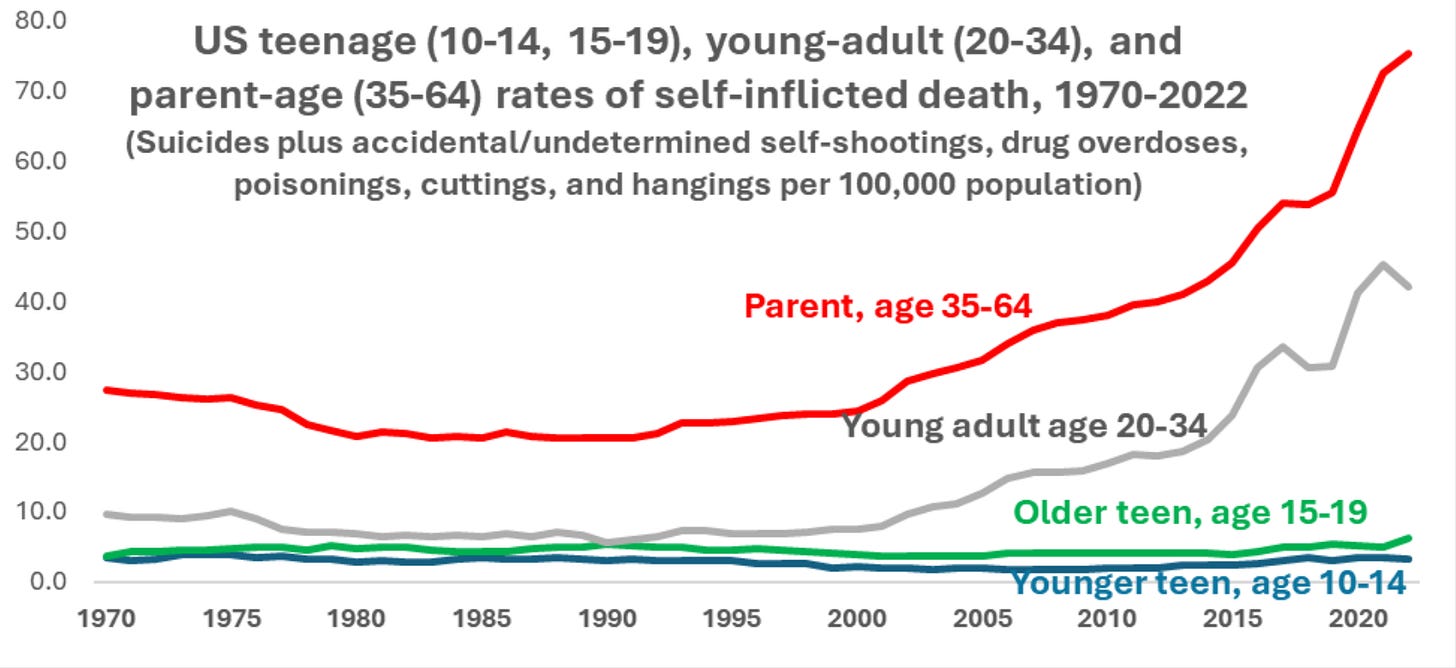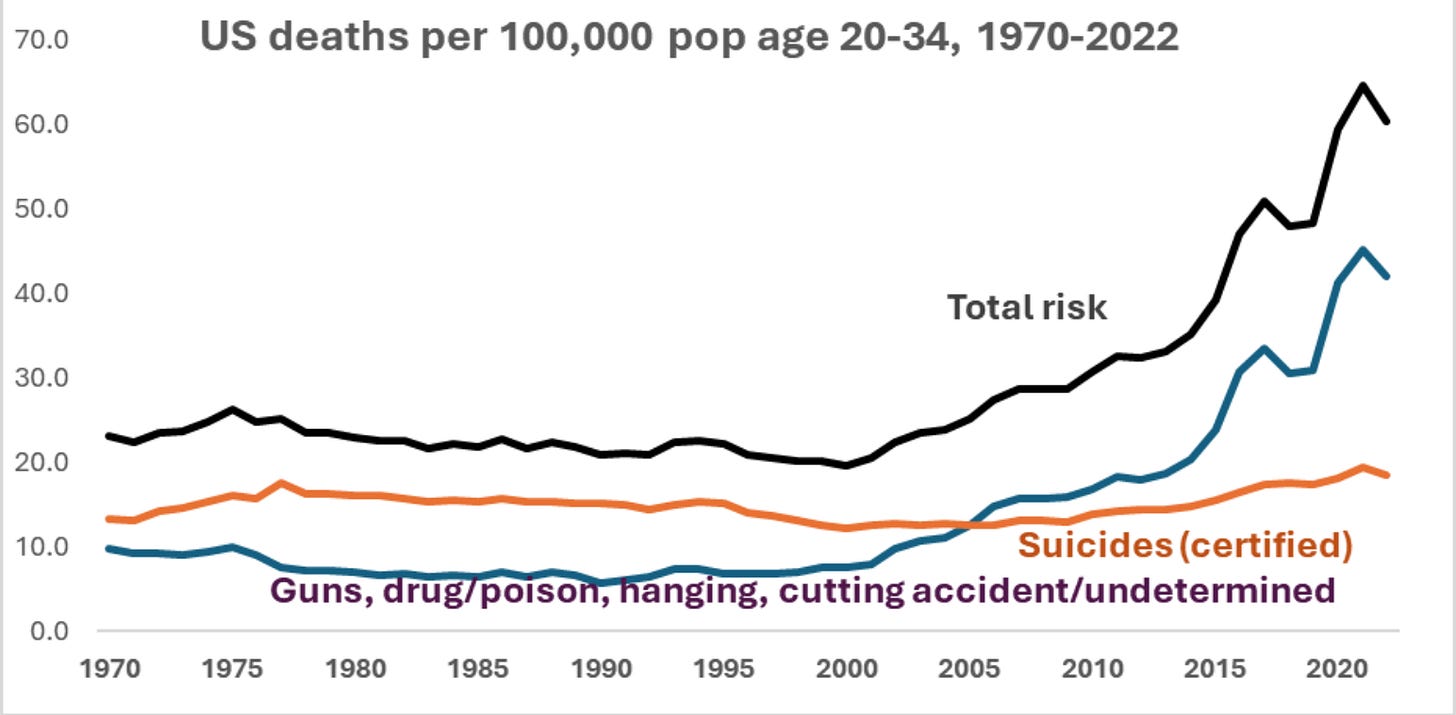Bad math + moral panic = terrible policy. In fact, teenagers are the one bright spot in America’s exploding epidemic of self-destruction
Grownup crises, not social media, are the real catastrophe
“Children’s advocates and lawmakers say companies are not doing enough to protect them,” reads a typical news lead on last week’s U.S. Senate hearings accusing social media giants of “child exploitation.” It should be the other way around.
Generation Z teenagers should be angrily grilling mental health professionals, “children’s advocates,” and lawmakers for 30 years of reckless disregard of national safety and children’s well-being.
The crisis is beyond urgent. American authorities’ grotesque derelictions have allowed self-destructive behaviors among grownups, including parents, to soar into the stratosphere while their political grandstanding pretends the crisis is just teenagers with Smartphones and TikTok.
Source: Centers for Disease Control. Note: this pattern has nothing to do with the relative size of the age groups. These death numbers are standardized per-person rates.
Authorities’ flawed mathematical choices have warped perceptions. First (expanding on Dr. David Stein’s “deaths of abandonment”), self-inflicted deaths of all types – overdoses and self-shootings, cuttings, and hangings rules as “accidents” or of “undetermined intent” – is a better index of the effects of self-destruction than suicides alone.
Second, because teen suicide and self-destruction are rare, fixating on percentage changes is misleading. It is meaningless to compare the PERCENT change in suicides for 10-14-year-old girls (who had 50 suicides a year) with, say, those of their mothers age 40-44 (900 suicides a year) or fathers age 40-44 (2,800). No one would claim a person who loses $5 on the first trip to Vegas and $20 the second (a “quadrupling” in gambling losses) has a bigger problem than someone who loses $200,000 the first time and $210,000 the second (“only” a 5% increase in losses).
The relevant index is not PERCENT change, but ABSOLUTE change that shows the real numbers of individuals and families impacted by behavior changes. Over the last two decades, the increase in suicides plus self-inflicted “accidents” and “undetermined” deaths reveals a change in behavior by 1.0 of every 100,000 younger teens age 10-14 and by 2.3 of every 100,000 older teens age 15-19.
However, among their parents, the increase in suicides and self-inflicted deaths represents a change in behavior by 50.9 of every 100,000 grownups ages 35-64 – a surge in per-capita self-destruction 22 times worse than among older teens and 50 times worse than among younger teens.
Even if we cherry-pick the worst period to make teens look as risky as possible, 2007 through 2020, the suicide and self-destructive death rate rose 20 times faster among their parents. Bottom line, whichever time period is picked: dozens of times’ more teenagers live in homes with suicidal and self-destructive grownups than the other way around, and that rising reality seriously affects teenagers’ mental health.
Yet, America’s authorities steadfastly refuse to admit that the appalling 785,000 parent-age self-destructive deaths during this period (equal to the disappearance of every middle-aged adult in a city of 2 million people), plus the millions of homes affected by lesser outcomes, could possibly be making teens more depressed. They have not even developed comprehensive measures to assess the impact of grownups’ self-destruction on teens.
Why did this disaster happen?
Because America’s medical and political establishment (while claiming not to) still crudely stigmatizes suicide, addiction, and mental health troubles as moral failings that must be blamed on powerless scapegoats like minorities, immigrants, and teenagers. Science disappears, useless emotional crusades ensue, and crises skyrocket – decade after decade.
Repeated misuse of “leading cause of death” to mislead ignorant audiences that teens suffer a “high rate” of suicide is statistical lying. Teens rarely die from heart disease, cancer, or COVID, so external causes like suicide become “leading causes” by default.
Because any increase in suicide, like any suicide itself, is a tragedy, emergency action to confront the grownup self-destruction crisis is urgent.
Instead, authorities concoct “studies” that omit parental troubles and fixate only on social media. They balloon tiny, superficial associations between screen hours and depression into an emotional crusade to ban teenagers from the social media forums teens tell the CDC they use to get medical and mental health services and make vital personal contacts that “get through tough times” – and which actually accompany fewer suicide attempts.
The catastrophic patterns shown here raise the question of why we are even talking about teenagers, other than as victims of disturbing grownup trends. American children and youth are being raised by the deadliest, most severely troubled generation of adults in documentable history, a development far more alarming than anything alleged about teens and social media.
The anti-teen, anti-social-media crusade is an escapist stampede in the destructive American tradition that make us the Western world’s most dangerous society by far. It has nothing to do with “protecting children.” Teenagers are right to find today’s situation more depressing and anxiety-causing. We should be shocked if they didn’t.
Fifty-year trends in self-destruction
Detailing long-term trends in self-destruction by age makes the issue even more alarming. The next three figures show a half-century of rates of certified suicides alongside rates of self-inflicted “accidents” and “undetermined intent” deaths (95%-plus self-inflicted) in the categories harboring nearly all suicides (guns, drug/poisonings, hanging/suffocations, and cutting instruments). When reading these charts, please keep the very different lefthand scales in mind.
First, for age 10-14, risk of self-inflicted death generally fell for 35 years after 1970 but has risen sharply since 2007, nearly all due to increased certified suicide. This indicates that at least some of the pre-2000 “increase” in young-teen suicide was an artifact of coroners’ increasing ability to distinguish suicides from self-inflicted “accidents.”
For age 15-19, risks declined somewhat from 1970 to 2000, then leveled off and rose sharply after 2012 due both the increased suicide and self-inflicted “accidents.” A smaller pre-1985 artifact of more suicides accompanying fewer self-inflicted “accidents” is indicated.
Young adults ages 20-34 show a middle-range trend, generally flat levels of certified suicide but skyrocketing rates of self-destructive deaths after 2000. Increases in suicide/self-destructive death rates are mammoth after the early 20s. Note that the lefthand scales increase radically for grownup graphs – which, again, shows why comparing “percentage” changes in adult and teen suicide/self-destruction are largely meaningless.
For ages that include most parents of teenagers, 35-64, the most disturbing pattern emerges. Certified suicide rates have remained steady with some recent increases, but self-inflicted “accidental” and “undetermined-intent” deaths have exploded since 1990.










Very limited and largely useless. Just as in the US, parents' deadly drug abuse has skyrocketed in the UK, Canada, and Australia, along with wider, related family- and community-level crises these trends bring. Yet, the Haidts in this discussion can't deal with those realities teens themselves have no choice but to face (even though I've repeatedly informed him of them, along with sources).
"Second, because teen suicide and self-destruction are rare, fixating on percentage changes is misleading. It is meaningless to compare the PERCENT change in suicides for 10-14-year-old girls (who had 50 suicides a year) with, say, those of their mothers age 40-44 (900 suicides a year) or fathers age 40-44 (2,800). "
I want to quibble about this one point. Sometimes percentage change is most appropriate, sometimes absolute change is. It all depends on what one is concerned about. If you are focused on the well-being of teens, when death is supposed to be rare (at least actuarially), then percentage change is absolutely a valid thing to be concerned about. Now if you are trying to compare one age group to another, as you do in this example, and they have wildly different base rates, then yes, I would agree that percentage change to compare the two is inappropriate.
That said, this is a great article.
"America’s authorities steadfastly refuse to admit that the appalling 785,000 parent-age self-destructive deaths during this period (equal to the disappearance of every middle-aged adult in a city of 2 million people), plus the millions of homes affected by lesser outcomes, could possibly be making teens more depressed. They have not even developed comprehensive measures to assess the impact of grownups’ self-destruction on teens."
The point you make about the choice by authorities to ignore the impact that the crisis of self-destructive deaths of parents, guardians, and caregivers may have on teens is an excellent one. Our concern for the well-being of teens should extend far beyond whether or not they choose suicide.
"The anti-teen, anti-social-media crusade is an escapist stampede in the destructive American tradition that make us the Western world’s most dangerous society by far. It has nothing to do with “protecting children.” Teenagers are right to find today’s situation more depressing and anxiety-causing."
Well said.